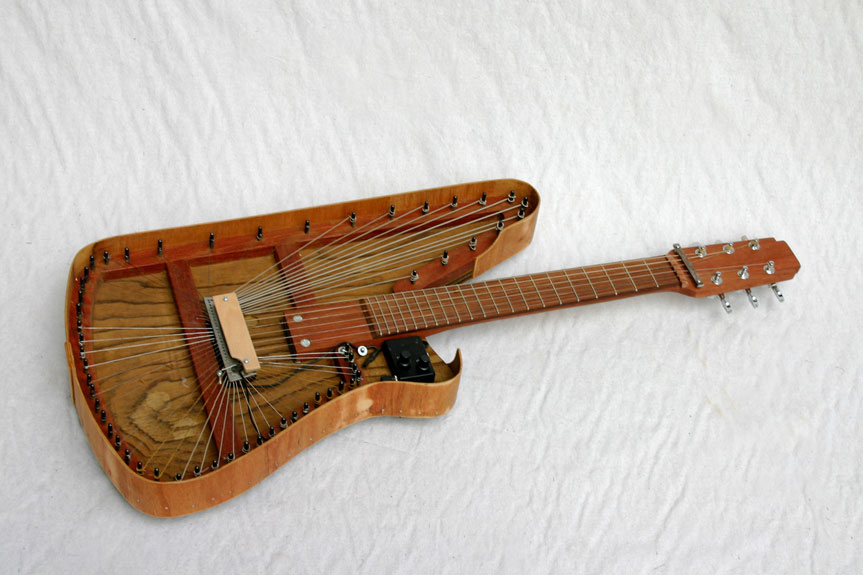 In this post you’ll find a description of a potentially very interesting idea in string instrument design. But as you’ll see as you near the end of the post, my attempt to exploit the idea wasn’t terribly successful. Still, it’s an interesting enough concept to justify this post describing it, especially if – who knows? – someone might find it promising enough to merit further exploration.
In this post you’ll find a description of a potentially very interesting idea in string instrument design. But as you’ll see as you near the end of the post, my attempt to exploit the idea wasn’t terribly successful. Still, it’s an interesting enough concept to justify this post describing it, especially if – who knows? – someone might find it promising enough to merit further exploration.
One of the main things affecting the character of an acoustic guitar is the soundboard resonances. These resonances color the tone by influencing the soundboard’s response to the string vibrations. I found myself wondering if it might be possible to replace the wooden soundboard with something that would allow deliberate tuning of resonances. To this end I designed a guitar in which the bridge, instead of being attached to a soundboard, is attached to an array of additional unplayed strings – many strings of varying lengths fanning out from the bridge in all directions in a plane mimicking the form of a soundboard. The six normal guitar strings, when played, deliver their vibrations to the bridge which in turn excites the many unplayed strings of the array.
A wooden guitar soundboard typically has many overlapping resonances, creating a cumulative resonance response that is not exaggeratedly frequency-specific. This allows it to respond well across the range of frequencies. Similarly, the idea of the string lattice guitar was to have enough strings to provide many overlapping resonances yielding a comparably balanced response. The maker or player would have the option of tuning these resonances by tuning these strings… or not: You could just leave the string tunings random, trusting that with so many strings the full range would be well covered and whatever frequencies might be introduced from the playing strings would find plenty of resonances somewhere among the many strings of the lattice. (To see that this actually is likely, bear in mind that each string of the lattice offers not only its fundamental frequency, but its harmonics as well). Alternatively, you could leave most of the strings random, but tune just a few for specific resonances you especially want to bring out. Or, for the anal types among us, you could deliberately tune all of the lattice strings for specific desired resonances.
To clarify the string configuration: the guitar body is shallow, with a back and short sides but no soundboard. The back and sides are strongly reinforced to take a great deal of string tension, and the many lattice strings – there are 54 if them altogether, did I mention that? – are attached, with zither pins for tuning, around the periphery. They come together at the bridge, which is a piece of steel bar with holes drilled around the edges for attaching the lattice strings. This bridge is not fixed to anything solid; it’s just held mid-air by the strings. The six played strings, coming in parallel from the neck, attach to the front of bridge. There is a magnetic pickup below the steel bridge which monitors the vibratory movement of the bridge as it moves in response to string vibrations from both the played strings and the lattice.
An important characteristic of wooden soundboards is that they are heavily damped. This means that the many resonance peaks are a bit broader (a bit less frequency-specific) than they would be in something less damped, like for instance a metal soundboard, and certainly much less than they would be in an attached string array. The damping also means that the resonances in the wooden board don’t sustain much independent of the driver (the played string). This again is very unlike the strings of an attached lattice, which will naturally tend to sustain well after the driving string has ceased. For these reasons, we can expect a string lattice to sound different from a wooden soundboard, regardless of how you might tune the strings of the lattice. It was my expectation, in exploring this design, that the instrument’s sound would be different from that of a wooden board, but hopefully different in interesting and enjoyable ways.
And here’s what I found when I had built the instrument and spent a little time with it (drumroll): well, actually, no drumroll please. I was disappointed. Broadly speaking, I just didn’t love the sound all that much. It came across to my ears as kind of clumsy and dull, lacking sparkle, brilliance and clarity. Retuning the strings of the lattice didn’t solve the problem: I could hear the effects of various retunings in terms of which resonances were highlighted, but I never did find an approach to lattice-tuning that seemed to bring the instrument to life. In the time since the instrument was made, I have occasionally come back to it, and I have even occasionally had fleeting moments thinking that there’s potential here yet. In the end, however, my original verdict of “not so great” has remained.
Ironically, people are always intrigued by the appearance of the instrument, with its string array mimicking the shape of a soundboard. In that regard it has been a success: people often want to photograph it.
My hope for this instrument is that there can be hope that there’s hope. Like, maybe someone else will be interested enough in the idea to explore it further, perhaps with some insights about more effective approaches, and will have more success than I did.
